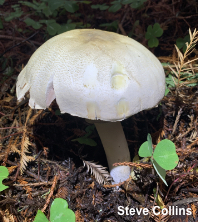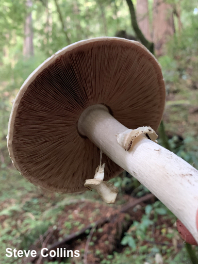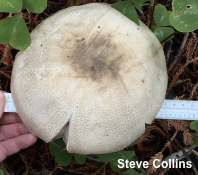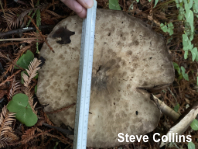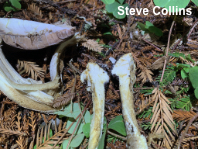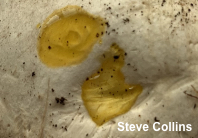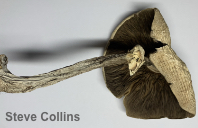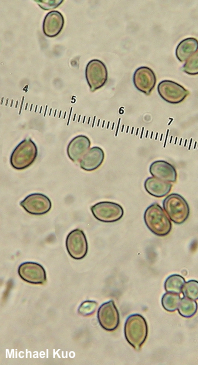| Major Groups > Gilled Mushrooms > Dark-Spored > Agaricus > Agaricus deardorffensis |

|
Agaricus deardorffensis [ Basidiomycota > Agaricales > Agaricaceae > Agaricus . . . ] by Michael Kuo This Agaricus is a large West-Coast regular, found in forests from coastal California to British Columbia, and in the Sierra Nevada. Its cap is brownish gray, with a darker center, and the surface of the cap is fairly smooth, with radiating, innate fibrils that occasionally make little flattened scales. The stem features a large, rubbery ring that often pulls away and attempts to live out a very bad 38 Special song from the early eighties ("Hold on Loosely"), and the flesh in the stem base turns yellow when crushed. For decades Agaricus deardorffensis went under the name "Agaricus praeclaresquamosus," but not only was that name nomenclaturally challenged, it was also applied to what turned out to be several species, according to Kerrigan (2016). Among these, Agaricus buckmacadooi is very similar in appearance, but can be separated with a suite of features that admittedly overlap: the cap scales of Agaricus buckmacadooi are darker, denser, and more scale-like; the flesh in the stem base is more prone to yellow staining in Agaricus deardorffensis; the ring of Agaricus buckmacadooi is less likely to hold on loosely; and the spores of Agaricus deardorffensis are slightly smaller. Thanks to Steve Collins for collecting, documenting, and preserving Agaricus deardorffensis for study; his collection is deposited in The Herbarium of Michael Kuo. Description: Ecology: Saprobic; growing gregariously in woods; fall and winter; originally described from the Sierra Nevada; also distributed on the West Coast from the Bay Area to British Columbia. The illustrated and described collection is from California. Cap: 15–25 cm at maturity; convex, expanding to broadly convex or nearly flat; dry; pale brownish to whitish, with a brown center; with brown, innate fibrils that form smooth, appressed scales; the surface often splitting radially; fresh, young specimens sometimes yellowing slightly when rubbed near the margin. Gills: Free from the stem or nearly so; close; short-gills frequent; pink, becoming brown and then dark brown in maturity; covered with a white partial veil when in the button stage. Stem: 15–25 cm long; 1.5–2.5 cm thick; equal; more or less bald; with a thick, rubbery, white ring that often loosens and hangs free; whitish; bruising slightly yellow at the base, or not bruising; basal mycelium white. Flesh: White; firm; unchanging when sliced, or becoming yellowish to yellow in stem base. Odor: Phenolic, or not distinctive. Dried Specimens: Brownish and brown, without yellow or orange shades. Chemical Reactions: KOH yellow on cap surface. Spore Print: Dark brown. Microscopic Features: Spores: 5–6.5 x 3.5–4.5 µm; ellipsoid; smooth; thick-walled; brown in KOH. Basidia 22–25 x 4–6 µm; subclavate; 4-sterigmate. Pleurocystidia not found. Cheilocystidia 20–30 x 4–11 µm; clavate to swollen and irregular; smooth; thin-walled; hyaline in KOH. Pileipellis a cutis; elements 5–12.5 µm wide, smooth, hyaline to brownish in KOH. REFERENCES: Kerrigan, 2016. (Arora, 1986; Kerrigan, 1986; Phillips, 1991; Kerrigan et al., 2005; Desjardin, Wood & Stevens, 2015; Kerrigan, 2016; Siegel & Schwarz, 2016.) Herb. Kuo 01262101. This site contains no information about the edibility or toxicity of mushrooms. |
© MushroomExpert.Com |
|
Cite this page as: Kuo, M. (2021, March). Agaricus deardorffensis. Retrieved from the MushroomExpert.Com Web site: http://www.mushroomexpert.com/agaricus_deardorffensis.html |
